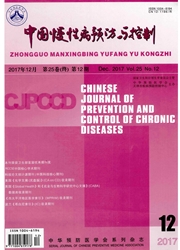

 中文摘要:
中文摘要:
目的探讨糖尿病并发高血压的相关危险因素。方法采用以社区人群为基础的成组病例一对照研究方法。对2型糖尿病患者中126例并发高血压的病例和273例未并发高血压的对照进行问卷调查、体格检查和实验室检测。采用Logistic回归模型对糖尿病并发高血压的危险因素进行比值比(OR)及其95%CI的分析。结果单因素Logistic回归分析结果表明,体质指数、腰臀比、主食摄入量与糖尿病并发高血压之间有统计学意义,OR及其95%CI分别为1.474(1.101~1.973)。1.478(1.180~1.852)和1.349(1.098~1.657),调整混杂因素后,仍有统计学意义。未发现糖尿病确诊年龄、糖尿病病程、血糖控制情况、体育锻炼、吸烟、饮酒、血清总胆固醇、甘油三酯、高密度、低密度和极低密度脂蛋白胆固醇水平与糖尿病并发高血压之间有统计学意义。结论体质指数高、腰臀比大以及主食摄人多可增加糖尿病并发高血压发生的危险性。
 英文摘要:
英文摘要:
Objective To explore the risk factors for complicated hypertension in type 2 diabetic patients. Methods A community-based case-control study was conducted and some risk factors of complicated hypertension in type 2 diabetic patients were analyzed. 126 cases and 273 controls were type 2 diabetic patients with and without hypertension respectively. Results The results from univariate lo gistic regression analysis showed that the occurrence of complicated hypertension in type 2 diabetic patients was statistically related to the body mass index (BMI), waist hip ratio (WHR) and the intake of grain crop. The corresponding OR with 95% CI were 1.474 (1.101- 1.973), 1.478 (1.180-1.852) and 1.349 (1.098-1.657), respectively. After adjusted for confounding factors, the associations mentioned above were still statistically significant. No associations were observed between complicated hypertension in type 2 diabetes and dia betes duration, glycemia control, exercise, smoking and alcohol drinking, serum total cholesterol, triglycerides, high density lipopro tein, low density lipoprotein and very low density lipoprotein cholesterol levels. Conclusion The high body mass index (BMI), high waist hip ratio (WHR) and high intake of grain crop may increase the risk for the complicated hypertension in type 2 diabetic patients.
 同期刊论文项目
同期刊论文项目
 同项目期刊论文
同项目期刊论文
 期刊信息
期刊信息
